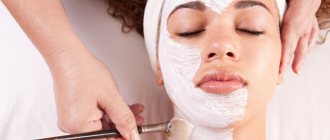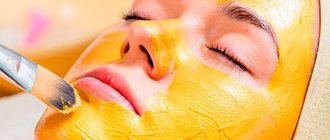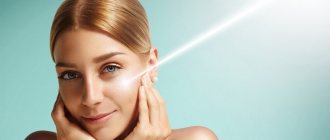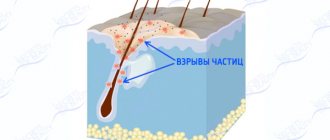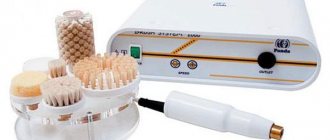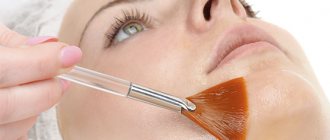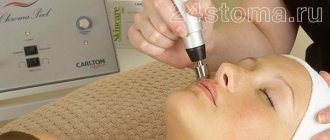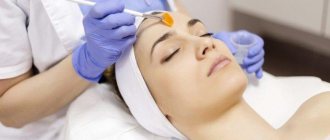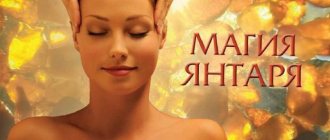Gayane Hovhannisyan
Cosmetologist/dermatovenereologist with more than 7 years of experience
Ask a Question
Retinoic (yellow) peeling is a popular, safe and effective cosmetic procedure. It has a complex effect on the skin, freeing it from old surface cells and launching natural processes of regeneration and rejuvenation in the dermis.
The composition of the drugs used includes a vitamin A derivative, which helps to increase the protective properties of the skin and prevent cancer.
Types of peeling with vitamin A derivatives
In practice, two types of yellow peeling are used:
- Retinol . The active substance in it is natural vitamin A (retinol). It is used alone or in combination with ascorbic and other acids. The effect of such peeling will be “soft” and gentle on the skin; adverse reactions are practically eliminated. Due to its naturalness, the procedure can be repeated monthly, without prior preparation.
- Retinoic (classic) . The active ingredient in it is isotrethionine (13-cis-retinoic acid, a synthetic analogue of vitamin A) in a concentration of 5 to 10%. Various manufacturers supplement it with auxiliary active substances. Retinoic peeling has a more aggressive effect on the skin and a pronounced effect. It is used no more than 2 times a year, with a minimum break between courses of two weeks.
There are two varieties of the classical method:
- One-day . The client leaves the cosmetologist with a mask on his face. The latter is washed off independently with water and products with a neutral pH after some time (most often after 12 hours).
- Two-day . In this case, the medicinal composition is applied several times over two days. The specialist decides which option to use after a preliminary consultation and examination of the skin type and condition.
Other effects of tretinoin overdose
Many people live on their skin with parasites such as iron acne, which is the cause of demodicosis. This mite is very common and some people are unaware of their existence as they are generally not a cause for concern. They live for themselves, well, okay.
But if the pH environment is disrupted, they begin to actively multiply and move from one area of the face to another - this is their survival mechanism. Mass death of arthropods after acid causes decay products, which intensifies demodicosis.
Comparing before and after will not cause joy, since you will have to stop the course and start removing the parasite.
In addition to this, the following disadvantages may also arise:
- Hyperpigmentation. Especially often it is mature skin that reacts this way, which acquires a darker color.
- Marbling. In this case, the skin has an uneven color: a pattern of pink and white spots. According to experts, livedo occurs due to the death of the cells responsible for the production of melanin.
- Old and new skins are different. The treated areas will look different from the untouched ones.
- Fibrosis due to destruction of basement membranes. This is how furrows, scars, folds, pimples, and orange peel appear.
Facial care after an overdose of vitamin A
If negative phenomena occur, you need to stop the course. Do nothing with your face for 4 days, no need to smear everything you come across... Since the skin will be dry, you will want to moisturize it. Fatty creams are contraindicated if there are signs of subcutaneous mites. A fatty environment is his favorite element.
If you start peeling the skin yourself, keloid scars may form, so don’t peel it… everything will come off on its own. On the fourth day, you can apply anti-inflammatory cream.
If atheromas appear, they can then be removed surgically.
Composition of retinoic peeling and its properties
Classic peeling, thanks to retinoic acid, has a yellow or orange color. It may include:
- vitamins - to enrich the skin with useful substances;
- plant extracts (aloe, chamomile) - for anti-stress effects;
- phytic acid - for anti-inflammatory and renewing effect;
- kojic acid - for the removal of dead cells;
- azelaic acid - to remove pigmentation and suppress the functioning of the sebaceous glands;
- allantoin - for a tightening, regenerating, rejuvenating effect.
The selection of specific substances is made by a cosmetologist, depending on the individual characteristics of the client.
How much does yellow peeling cost and can you do it yourself?
The price of the procedure depends on what peeling composition is used, who its manufacturer is, and what preparatory steps the cosmetologist recommended.
The average cost of one session is 4500–8000 rubles. More expensive drugs are available in a wide variety. But in general, the price depends on how famous the brand is.
The most popular today are the compositions of cosmetic lines from famous large manufacturers, for example, GIGI (Israel), CosMedix (USA), SesDerma (Spain). You can buy yellow peeling procedures for the face with a drug from a leading company by paying 10,000 rubles or more.
Cleaning with retinoic acid should only be carried out in a specialized salon. Since its effect can be compared to a medium peel, you cannot carry out the procedure yourself, despite all precautions. Even the slightest mistake can lead to irreparable skin pigmentation.
Pros and cons of the procedure
Yellow peeling has the following advantages:
- quick long-term comprehensive positive result;
- universal use for any skin type (even especially sensitive);
- superficial and gentle nature of the effect, minimal risk of undesirable consequences on the dermis;
- relative safety and painlessness of implementation, in comparison with other chemical peels;
- short recovery period - 1-2 days, less often up to 1 week.
Any peeling has its downsides, and retinoic peeling is no exception. Its disadvantages are:
- the possibility of an allergic reaction to the drug;
- the likelihood of undesirable consequences - too pronounced large-plate peeling, hyperemia, itching, swelling, tightness, etc.;
- the need to get home with a mask on your face and wash it off yourself at home - with one-day exposure;
- the relative duration of the procedure is for a two-day exposure.
The peeling has a rich yellow color, which, after rinsing off, can remain on the skin for some time in the form of a characteristic shade.
Post-peeling care
Compared to the recovery period for other types of peels, which is usually about 2 weeks, the recovery period for the yellow peel takes only 5 days.
Skin treated with peeling during these days requires special care: regular use of masks, special moisturizers and nourishing products.
After the procedure, the cosmetologist gives the following recommendations:
- do not use decorative cosmetics and products containing retinoic acid;
- during this period, do not carry out hair curling, dyeing, etc. procedures;
- it is necessary to use only herbal natural remedies that can reduce irritation and inflammation;
- when peeling, do not touch the skin with your hands;
- wash only with boiled water;
- use masks with lactic acid, which will moisturize the skin and help the skin renew itself much faster.
During this period, it is strictly forbidden to use scrubbing agents and be in the open rays of the sun.
Indications for yellow peeling
Peeling with vitamin A (retinoic) is recommended if you have:
- signs of aging on the skin, withering, ptosis of soft tissues associated with a decrease in the production of collagen and elastic fibers;
- noticeable defects in the skin texture (creases, scars, acne marks, etc.);
- pigmentation, freckles, signs of photoaging;
- increased oily or dry skin;
- hyperkeratosis, comedones (blackheads), acne and some other dermatological problems.
It is also indicated for the prevention of cancer processes on the skin, increasing its protection and local immunity.
Yellow peeling as a harmful and fictitious cosmetology service
Yellow peeling refers to the controlled, intentional damage to layers of skin using a chemical agent, which is retinoic acid. This substance makes it appear yellow. The main goal, as the providers of this service say, is to correct some aesthetic imperfections of the skin on the face:
- discard orange peel
- remove blackheads
- update color,
- rejuvenate by exfoliating old skin,
- remove dead cells.
Cosmetologists have found that depending on the concentration and duration of the procedure, the peeling effect increases. At first it was considered only a side effect, as it is undesirable for young skin. But it is needed for people over the age of 35. So they decided, the side effect became an end in itself. Here is a brief history of its appearance.
If for young skin this is not so traumatic, then for mature skin it causes some harm. The main reason: by the age of 35, chronic diseases develop, including dermatological problems, hormonal changes occur, the frequency of cell renewal slows down (in young people - 2.5 weeks, and after 30 years the process drags on for a month). Therefore, the consequences of the damaging factor of retinoids vary from person to person.
6 months of suffering for what?
Too long. The course lasts for 5-7 doses, and the break between them is 2 weeks. When the skin begins to peel off, it is impossible to simply go outside with such a face. At least you have to avoid acquaintances. How to go to work? After all, many women work communicating with people. Do you need to take a vacation at your own expense?
However, courses cannot be taken in spring and summer. Thirdly, you need to avoid direct sunlight. It is necessary to apply sunscreen, which must also be selected so that it does not contain any acids or other impurities.
The most unpleasant thing is rehabilitation. Before the course, you need to conduct a test to prevent unexpected results:
- red face,
- increased acne (oddly enough), after which wounds and pits remain,
- allergy to high retinoid content,
- activation of the skin demodex mite, which is the most unpleasant of all,
- additional costs for recovery and overcoming side effects (select and purchase ointments, creams, etc.).
As a result of the whole enterprise, you may not get the desired result: the skin with large pores and wrinkles remains the same. Well, she turned a little pinker, looks a little younger and lighter... And this is 6 months of suffering.
What is retinoic acid actually used for?
Let's be clear that there are many forms of axerophthol in ointments and creams:
- retinol acetate,
- its palmitate,
- retinol itself (concentration from 0.1 to 1%),
- retinaldehyde,
- tretinoin itself or Isotrtinoin (its final form that is required by the body). Acceptable 0.025%.
Only the fifth on the list is natural; the rest, when applied or taken, are converted in the body through several stages into that same retinoic acid.
In fact, this vitamin is prescribed to treat acne. Very concentrated and in limited quantities. The ointment itself is sold in many countries on prescription from a cosmetologist or dermatologist, as it causes an irritant effect on the epidermis (outer and lower layer). You can read more about axerophthol in the article “Top 10 natural vitamins for the face.”
Contraindications for exfoliation with vitamin A
Remember, it is a fat-soluble vitamin and can be produced through diet (such as carotenoids in fruits and vegetables) by the body itself. Thus, it accumulates and is not quickly removed, like water-soluble ones.
Retinol cleansing is contraindicated in the following cases:
- The presence of skin diseases (psoriasis, eczema, rosacea, active herpes virus, skin parasites, warts),
- Damage (wounds, scratches, burns),
- Sick liver
- Allergy to the composition of the product,
- Taking antibiotics together
- Combined use with roaccutane or other vitamin therapy drugs.
Why is retinol peeling prohibited during pregnancy?
Pregnancy and lactation are a special area of concern. Pharmaceutical companies are conducting preliminary studies on animals. There is also a practice of medical observations. In any case, manufacturers prohibit cosmetologists from performing this procedure on pregnant women. The mechanism itself is poorly understood and there are not enough scientific facts.
Firstly, during pregnancy there is a hormonal shift. Many physiological systems work differently. Yes, vitamin A is needed by pregnant women, but you should not overuse it, since we know that it accumulates in the liver. However, in itself it is useless if the body lacks zinc and vitamins E. Remember that tocopherol (Vit. E) is water soluble, which means it is excreted from the body, unlike Vit. A.
Scrubbing will be harmful for women in labor for two reasons:
- Retinoids penetrate through the dermis into the bloodstream and are distributed throughout the body. The unborn child becomes the center of a pregnant woman's body. Everything works for him. Remember that vitamins A forms are transformed several times to reach a bioavailable form.
- Second, the immunity of a woman who is expecting a child works differently. Your own immune cells are not enough to overcome the negative effects of chemical scrubbing. For example, an infection will get through a scratch or wound. And in the conditions of some cosmetology clinics, this is quite possible.
Photos of the results of using retinol
Having collected a lot of feedback from users, you can systematize the consequences into groups, which are represented by several photographs.
In general, they reflect unwanted side effects:
- Increased acne
- Demodicosis,
- The appearance of new marks from acne and “holes” where there were none before,
- Allergy.
Contraindications to retinoic peeling
Restrictions to retinoic peeling are:
- any violation of the integrity of the skin in the treatment area (cuts, burns, etc.);
- dermatological diseases (warts, seborrhea, eczema, etc.);
- acne in the active stage;
- individual intolerance to the components used;
- immunodeficiency;
- high photosensitivity of the skin;
- active infections, including herpes;
- serious diseases of the body, especially in the stage of decompensation (hepatitis, diabetes, etc.);
- recent use of retinoids (less than six months) and treatment with radiation, chemotherapy and antibacterial therapy;
- pregnancy, lactation - the last peeling with isotretionine (yellow) should be carried out at least six months before conception.
Many experts do not recommend carrying out the procedure before 35 years of age and during the summer season.
Contraindications
Like any type of peeling, retinoic peeling has contraindications:
- increased sensitivity to peeling components;
- the presence of acute viral diseases;
- warts and moles on the treated area;
- increased sensitivity to sun rays;
- taking certain medications;
- pregnancy;
- breastfeeding period;
- skin diseases;
- liver diseases.
When planning a pregnancy, you should not use retinoic peeling; it is better to resort to other methods of cleansing the skin.
If the patient constantly suffers from allergic reactions, in order to avoid complications, the doctor performs a sensitivity test; if there is no reaction, the cosmetologist performs the procedure.
Preparation for the procedure
Before coming for a classic peeling, you should prepare, which will take from 2 to 4 weeks. It includes:
- consultation with a cosmetologist, selection of a suitable drug;
- daily use of special cosmetics with fruit acids to make epidermal cells more pliable and soften the skin;
- refusal of any type of insolation, thermal procedures (sauna, steam bath) and some aesthetic manipulations;
- carrying out symptomatic measures (preliminary biorevitalization or mesotherapy for dry skin, antiviral therapy for herpes, etc.).
Peeling with fruit acids. Chemical peeling based on glycolic acid
Chemical peeling based on glycolic acid (25%, 50%) is the most common type of superficial peeling (affects only the top layer of skin). It is carried out using products based on glycolic acid. It belongs to the group of alpha hydroxy acids (or fruit acids). Found in beets, sugar cane and unripe grapes.
Glycolic acid can have an exfoliating effect, therefore it is widely used in peeling to solve problems such as fine wrinkles, enlarged pores, hyperpigmentation, post-acne, and increased activity of the sebaceous glands. Due to its low molecular weight, it easily penetrates the skin, where it affects the physiological state of the epidermis. In response to the damage caused by glycolic acid, the skin begins to actively launch recovery processes: it is renewed, moisturized, and becomes elastic. Due to this , a beautiful complexion is restored, all nervousness, fine wrinkles and acne go away .
Due to its superficial effect, glycolic peeling requires minimal recovery time.
Retinoic yellow peeling
Retinoic yellow peel (Retinol yellow peel, ampoule Spain) is one of the most popular medium peels. The peeling is based on retinoic acid, which is yellow in color (hence the name of the peel). The procedure can be performed on various skin types; it is recommended for the first signs of aging, hyperpigmentation, as well as for uneven skin surfaces (scars, cicatrices).
Retinoic acid is a fat-soluble acid and antioxidant. Upon penetration into the skin, it affects the epidermis, regulating the processes of keratinization and pigmentation. It restores the intercellular matrix, which gradually collapses with age (and as a result, wrinkles appear). One of the features of yellow peeling is that retinoic acid significantly reduces the level of sebum secretion. As a result of the procedure, blood and lymph circulation in the epidermis improves, the skin is cleansed, restored and takes on a healthy and well-groomed appearance !
Yellow peeling
Yellow peeling (YELLOV PEEL, cream mask USA) is one of the most gentle chemical peels. Yellow Peel is based on retinoic acid, which stimulates skin cells to produce collagen and elastin.
The Yellow Pell cream mask also contains ascorbic, phytic and other acids, which enhance the effect of retinoic acid and help eliminate hyperpigmentation. Yellow chemical peeling YELLOV PEEL is suitable for any skin type, it can even be performed in the eyelid area . Due to its gentle action, the rehabilitation period is only 2 - 4 days. The results are amazing: fine wrinkles are smoothed out, the skin becomes fresh and elastic , and hyperpigmentation disappears.
Milk peeling
Milk peeling is a “superficial” peeling. It is based on lactic acid, which improves blood microcirculation, ensures cell renewal, tightens and moisturizes the skin. Milk peeling is one of the most gentle chemical procedures. It is low-traumatic and has no side effects.
The uniqueness of this peeling is its effectiveness in a short time . Only 3 to 6 procedures are required. At the same time, the results exceed expectations: the skin is smoothed, takes on a healthy, juicy appearance, its tone and elasticity are restored. Milk peeling is indicated even for sensitive skin. The antioxidants included in the composition have an anti-inflammatory effect, so the procedure is effective for the treatment of acne .
Peeling Super Lift
Super Lift Instant Lifting is a chemical peeling procedure that instantly revitalizes the skin. The biocomplexes contained in the drug restore the healthy structure of the dermis and have a powerful lifting effect. It is based on fruit acids and phytoestrogens, which easily exfoliate dead skin cells and effectively smooth the skin surface. Super Lift peeling will provide a healthy, beautiful complexion and a smooth, delicate skin surface. The procedure is atraumatic, so it is suitable even for sensitive skin.
ABR peeling
ABR peeling is a peeling based on fruit acids with the addition of retinol. Refers to the middle type of procedure. Has a gentle and gentle effect. Effective against premature aging, problem skin, helps with acne, post-acne and hyperpigmentation.
The peeling contains alpha and beta acids (fruit and salicylic), which gently exfoliate dead skin cells, stimulate regenerative processes, as a result, smooth the surface and regulate sebum secretion. Thanks to the active stimulation of the production of collagen and elastin (fibers of “skin youth”), after the procedure, fine wrinkles are smoothed out and complexion improves . ABR peeling can be recommended even for teenagers to eliminate acne on the face.
TCA peeling
TCA peeling can be superficial, medium and deep. It is based on trichloroacetic acid, which helps get rid of wrinkles, hyperpigmentation, acne, and scars . The peeling also contains lyctocaine, which has a pronounced anti-inflammatory effect. This type of peeling is more suitable for patients with fair skin, as the results are more obvious. The rehabilitation period lasts 2 weeks, and the effect after the procedure will meet all expectations. The skin will become smooth, smooth, fine wrinkles will disappear, and a beautiful, fresh appearance will be restored.
Retinoic peeling technique
Experts note that it is advisable to carry out any peeling, including yellow peeling, in a salon. Manipulation done independently at home can lead to undesirable consequences and cause an unplanned effect.
The cosmetologist performs the following steps:
- cleansing the skin of impurities;
- applying a thin layer of a mixture of active ingredients (sometimes a slight tingling or pinching of the skin may be felt);
- sending the client home with a mask on his face, which must be washed off after a certain period of time (one-day session) or repeated application of the composition over two days.
After the classic peeling with retinoic acid has been carried out, the recovery period begins. The patient may experience peeling at the treatment sites, minor itching, swelling, soreness and tightness of the skin. These phenomena go away on their own after a few days. Otherwise, you should immediately consult a doctor.
Peeling protocol
Phase No. 2 - a gel with a characteristic pungent odor, contains dimethyl sulfoxide, which has a pronounced penetrating ability through the skin and mucous membranes, significantly increases the permeability of all biological membranes for the main active component - retinoic acid. Therefore, before applying Block Age Peel Gel, the use of any keratolytic preparations or other peeling compounds is not required. When water gets into the finished composition of Block Age Peel Gel, the specific odor intensifies, so only dry brushes and containers must be used for the procedure.
Stage I. Pre-peeling preparation
For 14-21 days at night, the patient should apply Prepeel Active or Prepeel Light cream to the facial skin, previously cleansed with Cleanser Mousse cleansing foam from the Medic Control Peel line. In the morning, apply Mediscreen SPF 85 sunscreen.
Stage II. Chemical peeling
1 step. Cleansing. Apply Cleanser Mousse to facial skin, distribute with light massage movements and leave for 1-2 minutes. Rinse with water. Dry the skin with a paper towel.
Step 2. Add the contents of the bottle phase No. 2 to the glass bottle phase No. 1, after which the glass bottle is tightly closed with a lid and mixed thoroughly, shaking for 2-3 minutes until a homogeneous transparent yellow mass without foreign impurities is formed. Pour the resulting composition (5 ml) from the bottle into a dry glass container convenient for the procedure. Use the finished composition within 24 hours.
Step 3. Using a dry brush, apply Block Age Peel Gel evenly to the skin. Do not apply to the eyelid area.
Step 4 On the face, the exposure time of the peeling composition varies from 4 to 12 hours: the rougher and more insensitive the skin and the more pronounced the hyperkeratosis and signs of aging, the longer the exposure time. When performing procedures on the body, the exposure increases to 16 hours.
Step 5 After applying Block Age Peel Gel to the skin of the face or body, the patient goes home. It is necessary to warn the patient that during the exposure time of the gel there may be a pronounced burning sensation, which spontaneously disappears within 1-2 hours, slight pastiness/swelling of the skin and increasing erythema. After the exposure time recommended by the specialist, the patient independently washes off Block Age Peel Gel with water and applies Vegefarma restorative moisturizer to the skin.
Stage III. Post-peeling care
The patient should apply Vegefarma cream as needed until the exfoliation process is completed. It is also necessary to protect the skin from ultraviolet radiation and use Mediscreen SPF 85 Medic Control Peel sunscreen.
Expected reactions
Erythema may appear in the area of the procedure (similar to active tanning in a solarium), which persists for 2-5 days. Slight swelling of the treated area is possible. 12-48 hours after peeling, depending on the severity of hyperkeratosis, large-lamellar or small-lamellar exfoliation (peeling) is observed in this particular patient. Due to the fact that retinoids penetrate the papillary dermis and enter the bloodstream, exerting a systemic effect, exfoliation can be observed even in areas where peeling was not performed. These phenomena are expected and are not symptoms of an allergic reaction. It is very important to inform the patient about this during the consultation. On days 2-3 after the procedure, the patient may be bothered by itching, as an individual reaction of the body to retinoids.
Skin care after the procedure
The rules of the rehabilitation period are as follows:
- if the composition is removed at home, use sponges or cotton pads moistened with water and products with a neutral pH level;
- daily care is carried out for the treated area, using healing agents and creams (D-Panthenol, Bepanten);
- for several days, while peeling occurs, you should not forcibly tear off the scales and layers of the epidermis or scratch the skin;
- before going outside, the skin is covered with sunscreen lotions with SPF 30 or more;
- makeup and aggressive cosmetics (scrubs, exfoliating wipes, etc.) are temporarily excluded.
For several weeks it is prohibited to visit the solarium, bathhouse, sauna, or gym. You cannot perform other cosmetic procedures, consume spicy foods and alcoholic drinks, or use hormonal drugs. It is advisable to reduce or completely eliminate nicotine consumption.
If peeling with retinoic acid does not cause significant peeling of the skin, you should not panic. This can happen for a number of reasons:
- individual characteristics of the epidermis (the layer of dead cells is so dense that it could not be prepared for the procedure and provided the desired effect, or the skin has a strong resistance to damage);
- different effects of the drugs (some formulations cause exfoliation on 2-3 days, others – after 1-2 weeks);
- all keratinized cells came off immediately when the mask was washed off (this happens in people with delicate thin skin);
- the cosmetologist performed a gentle procedure (this is possible if chemical peeling is performed for the first time in life, and the specialist consciously makes it softer).
Step-by-step instruction
If you plan to conduct a peeling course with retinoic ointment at home, you should set aside time for this. Usually women do cleansing during vacation, since the course takes more than one week. Peeling includes a preparatory, main and final stage.
Preparation for yellow peeling begins 2 weeks in advance. But if the skin is tanned, prone to oiliness and acne, then within 4 weeks. During the preparatory period you need:
- stop using acid-based cosmetics;
- do not visit solariums, beaches, bathhouses, saunas;
- regularly use glycolic cream to soften the outer keratinized tissue of the epidermis.
In fact, there are no differences in the main stage between salon cleansing and retinoic peeling at home, and how to do the procedure step by step is described below:
- Before applying the main composition, the skin is well cleansed and degreased.
- At the first stage, a cream based on glycolic acid is applied.
- The surface is treated with a preparation based on retinoic acid.
- The retinoic mask lasts for a maximum of 45 minutes. The time can be reduced depending on the condition of the skin and the desired result.
- If it is necessary to remove pigment spots, then they are carefully smeared with gentle pressure with a retinoic preparation using a cotton swab.
- When applying the mask, the skin around the eyelids and lips is not affected. Do not allow the drug to come into contact with the tongue or eyes. If such an oversight is made, then you must thoroughly wash your eyes or rinse your mouth, then immediately contact a medical facility.
- When 45 minutes have elapsed, combine water and soda and spread the mixture over the mask. These substances in the retinoic peeling recipe are necessary to neutralize acids. All this lasts for 8 hours.
- The session ends with washing with warm water and moisturizing the skin. Treatment with a moisturizer is a mandatory step, because after the session the skin tightens and becomes dry to the touch.
According to reviews from women, when peeling with retinoic ointment at home, a slight tingling and burning sensation is possible. Don't worry: this is a sign that the product is working. But if severe pain is felt, then you need to immediately interrupt the procedure, wash your face, and then go for a consultation with a dermatologist.
Possible complications after the procedure
Properly performed peeling, after the yellow mask is washed off, does not cause complications. Sometimes you may feel the urge to scratch your face and pick off dead skin. In the first few days, local reactions may be observed in the form of redness, swelling and tightness of the skin, but this is considered normal.
Negative consequences are possible under the following conditions:
- the technique of the peeling procedure was violated;
- the rules of preparation or rehabilitation period were not followed;
- low-quality drugs were used;
- individual intolerance or allergy suddenly appeared;
- there was an overdose of vitamin A, which can accumulate in the body.
The latter option is possible due to the simultaneous use of retinol topically and orally, as well as with excessive sun exposure. In case of overdose, the following may occur:
- symptoms of intoxication:
- pronounced local manifestations on the skin (severe itching, dermatitis, relapse of acne, hyperpigmentation);
- dry lips and mucous membranes of the eyes;
- decrease in the protective functions of the skin.
To avoid complications, it is necessary to carry out the manipulation by a qualified specialist and strictly follow his recommendations.
Side effects
Before performing the procedure, the cosmetologist warns the patient about possible side effects that can be avoided by following all the specialist’s recommendations. It is also important that the procedure is performed only in specialized centers where they use high-quality products and employ only qualified workers.
A reaction can occur due to the individual characteristics of the body, so it is important to inform the cosmetologist about the presence of diseases, which will reduce the risk of complications several times.
A couple of days after the procedure, the following side effects may occur:
- dry skin;
- tightness;
- peeling;
- the appearance of pink areas and redness;
- soreness;
- increased skin sensitivity;
- swelling.
These side effects almost always occur, which is the norm. To relieve discomfort, you need to use special products prescribed by a specialist that can moisturize and soothe the skin.
Expected effect after yellow peeling
After the layer of old epithelium comes off the skin, you can evaluate the result:
- increased production of hyaluronic acid, collagen and elastin fibers, supply of nutrients to cells and removal of toxins;
- general improvement and rejuvenation of the skin;
- elimination or reduction of pronounced wrinkles, creases, stretch marks, age spots, freckles and other skin defects;
- reduction of acne and acne scars, narrowing of enlarged pores;
- minimizing the risk of developing benign and malignant neoplasms on treated skin;
- strengthening the barrier function of the skin.
If dermatological problems are severe, several sessions with a cosmetologist may be needed to achieve the desired result. You can carry out the peeling procedure at the Novoklinik aesthetic medicine centers. You can sign up for a consultation by phone or on our website.
Cosmetic procedures are contraindicated during pregnancy and lactation.
Result of the procedure
After yellow peeling, the skin acquires a beautiful gloss, density, and elasticity. Pores shrink, texture improves, wrinkles smooth out and age spots lighten.
After the peeling course, the renewal process does not stop. For about another month, neocollagenesis occurs in the cells - the body produces elastin and collagen. This means that the condition of the skin will improve.
Yellow peeling helps rejuvenate the skin and give it a healthy and fresh look.
